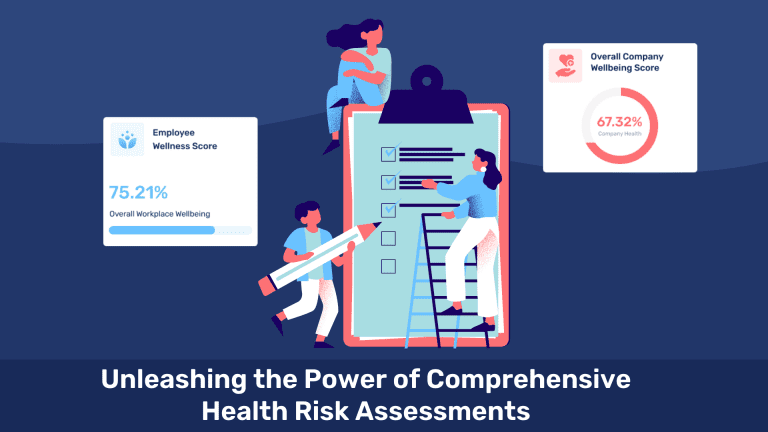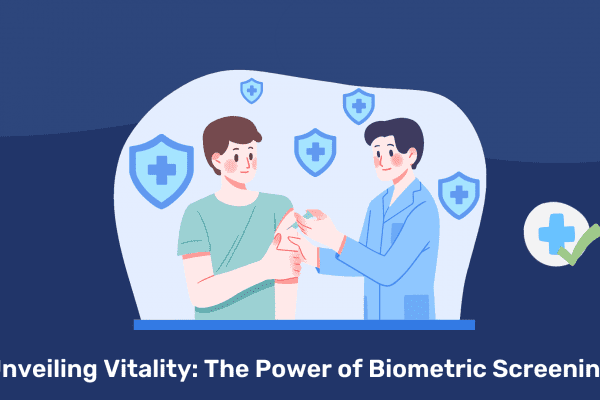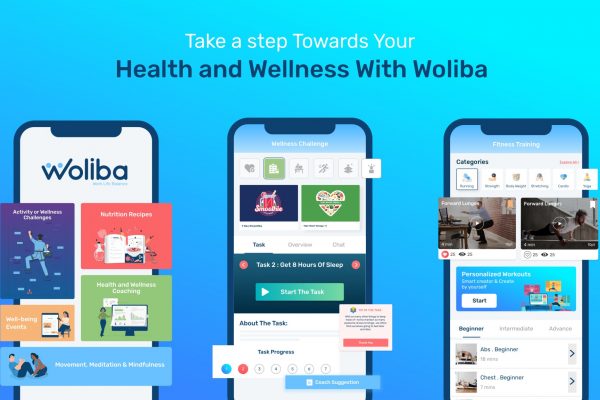Introduction
Welcome to the future of corporate wellness, where employee well-being takes center stage like never before. In today’s fast-paced corporate landscape, employee well-being has emerged as a top priority for forward-thinking organizations. Companies across industries are realizing that a healthy workforce is a productive workforce. Employee well-being encompasses physical health, mental wellness, social wellness and overall job satisfaction. As the realization of its importance spreads, organizations are actively seeking effective strategies to prioritize and enhance employee well-being.
In this content journey, we delve into the rising significance of employee well-being in the corporate world. We will explore a game-changing tool that is revolutionizing corporate wellness programs: Comprehensive Health Risk Assessments. These assessments go beyond traditional wellness evaluations by providing a holistic view of employee health. They not only can identify existing health risks & offer personalized recommendations for individuals to improve their well-being, but can transform your organization’s wellness strategy
By shedding light on the growing importance of employee well-being, we aim to inspire organizations to prioritize and invest in comprehensive wellness solutions. As we embark on this journey, prepare to discover how comprehensive HRAs can transform the well-being of your employees and, in turn, the success of your organization.
So, get ready to reimagine the value of HRAs and discover the critical role of choosing the right corporate wellness vendor to perform these assessments, leveraging health risk, biometric screening, and lifestyle surveys, while also providing an analytics dashboard for effective measurement. So, let’s dive in and unlock a new era of employee wellness!
Understanding the concept of Comprehensive Health Risk Assessments & its Prominence
Definition and Differences:
A comprehensive health risk assessment involves evaluating an individual’s medical history, lifestyle factors, family history, biometric measurements, occupational and environmental hazards, psychosocial aspects, health behaviors, and personalized risk stratification.
This assessment aims to identify potential health risks, categorize them, and provide personalized recommendations for prevention and intervention. It includes gathering information, measuring biometrics, assessing genetic and environmental influences, and considering mental health factors.
Based on the assessment, healthcare professionals offer education, counseling, and guidance to promote healthier behaviors and monitor progress over time.
Comprehensive Health Risk Assessment represent a new paradigm in evaluating employee well-being. Unlike traditional assessments that focus solely on individual health parameters, comprehensive HRAs adopt a holistic approach. They take into account multiple facets of an individual’s health, including health risk evaluations, biometric screenings, and lifestyle surveys.
Components of Comprehensive Health Risk Assessments:
- Health Risk Evaluations: Comprehensive Health Risk Assessments include in-depth evaluations of an individual’s health risks. These assessments typically involve comprehensive questionnaires that cover a wide range of health-related topics, such as medical history, family health history, lifestyle choices, and stress levels. By collecting comprehensive information, HRAs can identify potential health risks and provide early intervention opportunities.
- Biometric Screening: In addition to evaluating health risks, comprehensive Health Assessments often incorporate biometric screenings. These screenings involve measurements such as blood pressure, cholesterol levels, body mass index (BMI), and blood sugar levels. By collecting objective data, HRA can provide an accurate assessment of an individual’s current health status.
- Lifestyle Surveys: To understand the holistic well-being of employees, comprehensive Health Assessments include lifestyle surveys. These surveys capture information on various lifestyle factors, such as exercise habits, nutrition, sleep patterns, stress levels, and mental well-being. By considering lifestyle choices, Health Risk Assessments can provide personalized recommendations for improving overall health and well-being.
Benefits of Health Risk Assessments:
- Early Detection of Health Risks: Comprehensive Risk Assessments are designed to identify potential health risks at an early stage. By assessing an individual’s health history, family background, and biometric data, Health Risk Assessments can detect underlying health issues before they become more severe. Early detection allows for timely intervention and proactive health management.
- Personalized Wellness Recommendations: A key advantage of comprehensive Risk Assessments is their ability to provide personalized wellness recommendations. By analyzing the collected data, Health Risk Assessments can offer tailored advice and action plans for each individual. These recommendations can include suggestions for improving nutrition, increasing physical activity, managing stress, and seeking appropriate medical care. Personalized guidance enhances engagement and empowers employees to take control of their well-being.
- Reduced Healthcare Costs: Comprehensive Health Assessments have the potential to reduce healthcare costs for both employees and employers. By identifying health risks early on, individuals can take proactive steps to address their health issues, which can prevent the progression of chronic conditions and the need for costly medical interventions. Moreover, personalized wellness recommendations can guide individuals towards healthier lifestyle choices, leading to a decreased risk of developing costly health conditions.
- Holistic Approach to Employee Health: Employee well-being extends beyond physical health alone. Mental well-being, stress management, and work-life balance are crucial components of overall wellness. Comprehensive Risk Assessments consider these aspects through lifestyle surveys, providing a more holistic view of employee health. By addressing the multifaceted nature of well-being, organizations can foster a healthier and more productive & engaged workforce.
Importance of a Holistic Approach:
A holistic approach to employee health recognizes that physical and mental well-being are interconnected. Comprehensive HRAs play a pivotal role in promoting this perspective by considering various aspects of health.
By integrating health risk evaluations, biometric screenings, and lifestyle surveys, Health Risk Assessments provide a comprehensive snapshot of an individual’s well-being. This holistic understanding allows organizations to develop targeted wellness initiatives that address the specific needs of their employees, resulting in improved health outcomes and increased employee satisfaction.
The Role of Analytics in Measuring Health Risk Assessments & Wellness Metrics
Emphasizing the Significance of Data Analytics:
Data analytics plays a pivotal role in corporate wellness programs, especially when it comes to measuring the effectiveness of HRAs . By harnessing the power of analytics, organizations can gain valuable insights into employee health and well-being. Analytics enable a data-driven approach, allowing for informed decision-making and the optimization of wellness initiatives.
Transforming Raw Data into Actionable Insights:
An analytics dashboard acts as a transformative tool by converting raw data from Health Assessments into actionable insights. Instead of drowning in a sea of numbers, organizations can extract meaningful information from the data collected through comprehensive Health Risk Assessments. Analytics algorithms and tools process the data, identifying patterns, correlations, and trends. This analysis unveils crucial insights that help organizations understand the health profiles and needs of their employees.
Advantages of Real-Time Data Visualization and Robust Reporting:
One of the key advantages of analytics dashboards is the ability to visualize data in real-time. Real-time data visualization allows organizations to monitor wellness metrics and track changes over time. By presenting data in visually engaging formats, such as charts, graphs, and interactive dashboards, analytics provide a clear and intuitive understanding of employee health. Additionally, robust reporting capabilities enable organizations to generate comprehensive reports, showcasing wellness program outcomes, trends, and areas of improvement.
Driving Informed Decision-Making and Shaping Wellness Initiatives:
Analytics empower organizations to make informed decisions based on data-driven insights. By analyzing Health Risk Assessments and wellness metrics, organizations can identify high-risk individuals, prevalent health issues, and areas for targeted intervention. Analytics provide a deep understanding of the impact of wellness initiatives, allowing organizations to refine and tailor their programs to maximize effectiveness. With data as their compass, organizations can make strategic decisions that positively impact employee well-being and drive long-term improvements in health outcomes.
Search for the Right Corporate Wellness Solution for Comprehensive Health Risk Assessments : Evaluating Capabilities
Choosing the right corporate wellness vendor is critical when implementing comprehensive Health Risk Assessments . The vendor acts as a partner in the wellness journey, providing the necessary expertise, resources, and support to ensure the success of the program. A well-selected vendor can significantly enhance the effectiveness of Health Risk Assessments and overall wellness initiatives.
Key Considerations for Vendor Selection:
-
Vendor Expertise
Look for a vendor with extensive experience and expertise in the field of corporate wellness. A knowledgeable vendor understands the complexities of employee health and well-being and can tailor Health Risk Assessments accordingly. They should be well-versed in the latest industry trends and best practices, ensuring that the assessments are comprehensive and aligned with organizational goals.
-
Reputation and Track Record
Assess the reputation and track record of potential vendors. Seek reviews from portal like G2 Crowd & Gartner and recommendations from other organizations that have utilized their services. A vendor with a proven track record of success demonstrates reliability, credibility, and the ability to deliver high-quality Health Risk Assessments solutions.
-
Comprehensive Health Risk Assessments
When evaluating vendors, it is crucial to ensure that they offer Health Risk Assessments that encompass various components. Look for a vendor who can perform health risk evaluations, biometric screenings, and lifestyle surveys as part of their Health Risk Assessments solution. This comprehensive approach provides a holistic view of employee well-being and allows for targeted interventions based on individual needs.
-
Gamification Features
Consider vendors who incorporate gamification features into their wellness platform. Gamification elements can incentivize employees to participate actively in Health Risk Assessments, surveys, and biometric screenings. Rewards, badges, and friendly competitions can boost engagement and motivate employees to take proactive steps towards their well-being. This approach increases participation rates, resulting in more accurate and comprehensive data collection. Ultimately, the gamification elements make the process of improving health and wellness more enjoyable and interactive for employees.
-
Incentives and Personalized Activities
A desirable vendor should provide the ability to customize activities and incentives based on an individual’s health risk profile. This customization ensures that employees receive relevant recommendations and are incentivized to participate in wellness initiatives specific to their needs. Offering personalized activities based on health risks and providing incentives for participation can increase engagement and foster a culture of proactive well-being.
-
Inclusion of an Analytics Dashboard
Look for a vendor which provides an analytics dashboard for effectively measuring and tracking wellness metrics. The dashboard should offer real-time data visualization and reporting capabilities. It allows organizations to monitor the impact of Health Risk Assessments and wellness initiatives, track participation rates, and analyze trends in employee health. The analytics dashboard provides actionable insights, enabling organizations to make data-driven decisions, refine wellness strategies, and demonstrate the return on investment (ROI) of their wellness programs.
-
Easy Customization Options
Look for a vendor that provides customization options for Health Risk Assessments. This allows the assessments to be tailored to the specific needs and goals of your organization. Customization ensures that the assessments align with your unique wellness program objectives.
-
Easy Implementation Option
When choosing a corporate wellness vendor for Health Risk Assessments, prioritize easy implementation. Look for a vendor that offers seamless integration, a user-friendly interface, and comprehensive training and support. Opt for a solution that minimizes administrative burden through streamlined processes and automation. Additionally, consider a vendor that offers flexibility and scalability to adapt to your organization’s evolving needs. By prioritizing easy implementation, you can ensure a smooth transition, maximize employee engagement, and minimize disruption to daily operations, enabling you to quickly realize the benefits of Health Risk Assessments for improved employee well-being and organizational success.
Woliba.io :Transforming Comprehensive Health Risk Assessments in Corporate Wellness
Woliba.io revolutionizes comprehensive Health Risk Assessments in corporate wellness. With its user-friendly interface, customization options, and powerful analytics dashboard, Woliba.io takes a holistic approach to employee well-being
- Comprehensive Health Risk Assessments: Woliba.io provides comprehensive Health Risk Assessments that encompass health risk evaluations, biometric screenings, and lifestyle surveys. These assessments go beyond traditional methods by considering six key categories: Health, Nutrition, Workplace Wellness, Physical Activity, Lifestyle, and Emotional Wellness. By compiling Health Risk Assessments reports with biometric data screenings and lifestyle surveys, Woliba.io offers a holistic and in-depth assessment which enables the generation of valuable insights into employee health profiles and allows for personalized wellness recommendations based on individual needs and preferences.
- Customization Options: Woliba.io allows organizations to customize Health Risk Assessments to align with their specific wellness goals and corporate culture. Tailored assessments ensure relevance and engagement for employees.
- User-Friendly Analytics Dashboard: Woliba’s intuitive analytics dashboard simplifies the measurement and tracking of wellness metrics. It provides clear data visualization and actionable insights for effective decision-making.
- Gamification and Incentivization: Woliba.io incorporates gamification features, such as rewards, badges, and friendly competitions, to boost employee engagement and encourage active participation in HRAs and other health challenges. Incentivization further motivates employees to make positive changes to their well-being.
- Easy Implementation :Woliba.io streamlines the implementation process, ensuring a seamless alignment into your organization’s wellness initiatives. The app’s intuitive setup and user-friendly interface make it easy for employees to get started and engage in the Health Risk Assessments process and be holistic without any hassle.
Making the Decision and Taking Action
Summarizing the Key Points:
Throughout this content journey, we have explored the value of comprehensive Health Risk Assessments in corporate wellness solutions. We discussed how Health Risk Assessments differ from traditional assessments and highlighted their components, including health risk evaluations, biometric screenings, and lifestyle surveys. The benefits of HRAs were emphasized, such as early detection of health risks, personalized wellness recommendations, reduced healthcare costs, and a holistic approach to employee health. Additionally, we discussed the significance of data analytics in measuring wellness metrics and the role of a user-friendly analytics dashboard in transforming raw data into actionable insights.
Encouraging Evaluation of Current Corporate Wellness Strategies:
It is crucial for readers to evaluate their current corporate wellness strategies in light of the information shared. Reflect on the effectiveness of existing wellness initiatives and assess whether Health Risk Assessments are being utilized. Consider the potential benefits of incorporating comprehensive Health Assessments and how they can enhance the well-being of employees. Recognize the importance of prioritizing employee health and well-being as a key driver of productivity and organizational success.
Providing Actionable Steps:
To implement a comprehensive Health Risk Assessments program, take the following actionable steps:
- Evaluate Vendor Capabilities: Consider the checklist of essential features when evaluating corporate wellness vendors. Assess their expertise, reputation, track record, and ability to perform comprehensive Health Assessments. Pay attention to customization options, a user-friendly analytics dashboard, and gamification features for increased engagement.
- Select the Right Corporate Wellness Vendor: Choose a vendor that aligns with your organization’s goals and values. Ensure they can perform Health Assessments, including health risk evaluations, biometric screenings, and lifestyle surveys. Look for vendors with gamification features that incentivize participation and access to personalized activities based on health risks.
- Implement the Comprehensive Health Risk Assessments Program: Work closely with the chosen vendor to integrate the HRAs program into your organization. Communicate the program effectively to employees, emphasizing the value and benefits. Encourage active participation and engagement by highlighting the personalized recommendations and incentives offered.
Emphasizing the Importance of Prioritizing Employee Well-being:
Creating a healthier and more engaged workforce starts with prioritizing employee well-being. By implementing Health Risk Assessments and fostering a culture of wellness, organizations demonstrate their commitment to the health and happiness of their employees. Recognize that employee well-being is not just a moral obligation, but also a strategic investment that leads to increased productivity, reduced healthcare costs, and a positive work environment.
Conclusion
In conclusion, evaluating current wellness strategies, considering the value of Health Risk Assessments, selecting the right vendor, and taking action to implement a Health Assessments program are essential steps to prioritize employee well-being and create a healthier, more engaged workforce. By embracing comprehensive Health Risk Assessments, organizations can unlock the full potential of their wellness initiatives and contribute to the long-term success of both employees and the organization as a whole.



